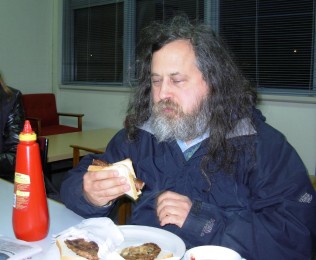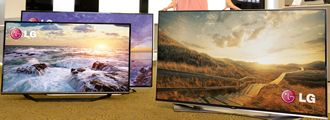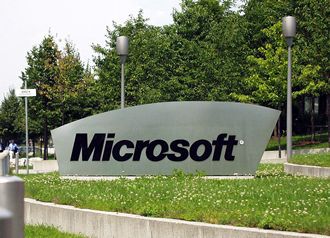 Restructuring and mergers are creating something of a boom in IT spending for utility companies in Western Europe.
Restructuring and mergers are creating something of a boom in IT spending for utility companies in Western Europe.
 Restructuring and mergers are creating something of a boom in IT spending for utility companies in Western Europe.
Restructuring and mergers are creating something of a boom in IT spending for utility companies in Western Europe.
 In a bid to generate more revenues, graphics firm Nvidia is to start licensing its GPU designs to other companies.
In a bid to generate more revenues, graphics firm Nvidia is to start licensing its GPU designs to other companies. A US court has ruled that sometimes it is OK to melt your hard drive and you will not be accused of destroying evidence.
A US court has ruled that sometimes it is OK to melt your hard drive and you will not be accused of destroying evidence.
Malibu Media was carrying out a file-sharing lawsuit against an alleged file-sharer. The defendant said that the hard drive failed and it had to be replaced. Malibu Media claimed that this act alone constituted destruction of evidence and wanted victory declared and the file sharer crucified as a warning to others – or something like that.
Magistrate judge Mark Dinsmore said recommended that Malibu Media’s “Motion for Sanctions Against Defendant for the Intentional Destruction of Material Evidence” be denied.
Malibu Media, is a porn company, which is having a few of its cases stick lately, particularly its flick “Pretty Back Door Baby” which appeared on BitTorrent in 2012.
The defendant explained that the drive was taken to recycling where it would be melted down. Malibu pointed out that the Defendant received notice of this lawsuit in October 2012 through the letter from Comcast and that the hard drive that Defendant replaced in early 2013 could have, “contained evidence of Plaintiff’s copyrighted works.”
However, the court said that the porn company had failed every element of the test for proving that the evidence was destroyed before the defendant knew he was being sued.
“Sanctions for spoliation therefore may not be imposed simply because evidence was destroyed; instead, such sanctions are appropriate only if the evidence was destroyed for the purpose of hiding adverse information,” the court said.
The court noted that the defendant received notice of this lawsuit at the beginning of October 2012, but did not destroy the hard drive until “late February 2013”.
Had Defendant truly wished to hide adverse information, the Court finds it unlikely that Defendant would have waited nearly five months to destroy it. In fact, the Defendant’s continued use of the hard drive for the months after he learned of the litigation suggests that the hard drive contained no information to hide at all, or that Defendant did not intend to hide any such information.
There was also evidence that Plaintiff, however, did not serve the complaint on Harrison until April 2013, after Defendant had arranged to order the replacement hard drive, and after the recycling of Defendant’s hard drive.
The Defendant testified that the service of the complaint was the first time that he became aware that he was personally being sued for copyright infringement. At the time of the destruction in February 2013, Defendant was not even certain he had been sued, making it much less likely that he destroyed the hard drive to hide information that could prove damaging in this litigation.
The Defendant also had a receipt for the hard-drive something that he showed the court. The court felt that it was unlike he would have produced the receipt showing the purchase of the hard drive had Defendant wished to hide the purchase of the replacement hard drive.
It puts the porn company’s entire case on the back foot. Suddenly there was no evidence to suggest that the destroyed drive was involved in the alleged acts of copyright infringement and no conspiracy to destroy evidence. The court also sided with the defendant that the drive was not even used for the purposes of using BitTorrent.
 Software giant Microsoft has had the embarrassment of having its Xbox One SDK leaked to the great unwashed by an open sauce group calling itself H4LT.
Software giant Microsoft has had the embarrassment of having its Xbox One SDK leaked to the great unwashed by an open sauce group calling itself H4LT.
H4LT insists that it is not a hacker group, but is distributing the SDK to improve the software.
“Progress is achieved faster than alone. Something kept between us will not achieve anything. Share it with the community equals creativity and research. Shared is how it should be. The SDK will basically allow the community to reverse and open doors towards homebrew applications being present on the Xbox One,” the group announced to Hot Hardware .
The SDK for any given product is available behind some degree of registration and does not necessarily cost users. So getting your paws on a copy was not a matter of sneaking it out of a heavily guarded back vaults using minis.
The SDK includes Microsoft’s Pix which shows that the Xbox One’s has an optional seventh core for game programming. There are also multiple Xbox Kinect tools, including the Kinect Studio and the Kinect Visual Gesture Builder.
Kinect also has an app for testing and creating applications that listen for speech.
The group has also claimed that once the SDK is out, people who have knowledge or has in the past reversed files related to the Windows 8 operating system should definitely have a go at reversing some files in there.
The Xbox One is practically a stripped Windows 8 device and has introduced a new package format that hasn’t had much attention. This format is responsible for updating the console and storing applications Games are under the category of ‘Applications’ on the Xbox One and is a modification of Virtual Hard Disks.
 The once legendary news agency Reuters has begun hawking Apple’s up and coming toy watch, which is being delivered two years behind the competition, and without any killer apps.
The once legendary news agency Reuters has begun hawking Apple’s up and coming toy watch, which is being delivered two years behind the competition, and without any killer apps.
Reuters ran a story this morning saying that “Apple’s forthcoming smartwatch poses a conundrum for advertisers: How to tap the enticing possibilities of the tiny gadget without overwhelming consumers with messages.”
Is it? Well not really. Some company mobile-marketing firm TapSense plans to release an Apple Watch ad-buying service at CeBit and since there is no way that Reuters can write a positive iWatch story this week it has had to run with this one.
According to Reuters: “The service will provide a first glimpse of how businesses can serve up ads on the watch, even though the gadget will not be available until later this year.”
Surely that is only a problem if the iWatch was “ground-breaking, new technology” which had not already been in the market place for two years and been greeted by a loud sounding yawn by the rest of the world.
But Reuters warns the same qualities that render the watch exciting to Madison Avenue, such as the ability to detect customers approaching a store and to zap an ad directly to their wrists, also risk alienating those customers.
Is it? The iPhone has been around for years and it has never used that sort of technology. Instead what TapSense seem to be selling are interactive wallpapers on the watch dial with brand logos and personalised clock faces.
The watch’s main screen allows the display of several tiny icons, including for email, weather, time, and potentially a few favourite service and retail apps.
The start-up is exploring using Apple Watch’s location-based features to target new customers. Apple has not added global positioning on the Apple Watch, but apps can track location as the device is tethered to a smartphone.
Reuters admits that it is not clear if the iWatch will create a new mass-market category, Venture capitalist Fred Wilson caused a stir last week by predicting the watch “will not be the home run product that iPod, iPhone, and iPad have been”.
But with the mainstream press pushing non-stories to the great unwashed about the vapourware, it does have a chance of selling more than its rivals.
 Nvidia unveiled a new processor aimed at powering high-end graphics on car dashboards as well as auto-pilot systems.
Nvidia unveiled a new processor aimed at powering high-end graphics on car dashboards as well as auto-pilot systems.
Before the Consumer Electronics Show, Nvidia Chief Executive Jen-Hsun Huang said the Tegra X1 chip would provide enough computing for automobiles with displays built into mirrors, dashboard, navigation systems and passenger seating.
“The future car is going to have an enormous amount of computational ability,” Huang said. “We imagine the number of displays in your car will grow very rapidly.”
The Tegra X1 has twice the performance of its predecessor, the Tegra K1, and will come out in early 2015, Nvidia said.
A platform combining two of the X1 chips can process data collected from up to 12 high-definition cameras monitoring traffic, blind spots and other safety conditions in driver assistance systems, Huang said.
The chips can help detect and read road signs, recognise pedestrians and detect braking vehicles before you do.
Nvidia has been struggling to compete against larger chipmakers like Qualcomm in smartphones and tablets and thinks that its Tegra mobile chips will be better off in cars and is already supplying companies including Audi, BMW and Tesla.
In the third quarter, revenue from Tegra chips for automobiles and mobile devices jumped 51 percent to $168 million. While this is not bad it is a Fiat 500 to Nvidia’s Mac Truck of total revenue of $1.225 billion.
 Vuzix has told the world+dog that the small time chipmaker Intel has invested $24.8 million in the company to speed up the launch of its internet-connected specs.
Vuzix has told the world+dog that the small time chipmaker Intel has invested $24.8 million in the company to speed up the launch of its internet-connected specs.
Intel bought preferred stock that is convertible into common shares equivalent to 30 percent of Vuzix, Vuzix said in a press release.
New York-based Vuzix develops computerised, internet-connected glasses and other video eyewear aimed at consumers, businesses and entertainment. Intel is dead keen to get its foot in the door of such market having been too late into the smartphones and tablets fad.
It is the second big deal to be announced in a month. In December, Italy’s Luxottica said it was joining forces with the US chipmaker to develop glasses that combine its top fashion brands with technology that could allow wearers to access information about their health or location.
Intel has also teamed up with watch retailer Fossil and fashion brand Opening Ceremony to develop wearable devices such as fashion bracelets with communications features and wireless charging.
It is all early days yet, but it seems that Intel is preparing the ground.
 While times were slack for LCD TVs during 2013, the market swung sharply upwards in 2014 and times ahead look rosy too.
While times were slack for LCD TVs during 2013, the market swung sharply upwards in 2014 and times ahead look rosy too.
That’s the prediction market research company Displaysearch makes, saying that total units shot up by 10 percent in the third quarter of 2014. It estimates that total shipmets for 2014 will amount to 223 million units, a rise of seven percent over the year before.
Sales were particularly strong in North America and Asia Pacific, according to senior research analyst Paul Gagnon. He said growth was fuelled by people replacing older flat panel TVs while in Asia many had moved away from CRT (cathode ray tube) TVs to LCD TVs.
Larger screen sizes apears to be the name of the game, as vendors seek to encourage people to upgrade. And there’s increasingly strong demand for 4K LCD units – Displaysearch estimates that the market for these will grow by over 50 percent in 2015, amounting to 32 million units.
But there’s a warning to manufacturers too – Gagnon said that they have to be careful they don’t end up with too much stock during the first quarter of this year.
That might be bad news for them, but it’s likely to make the price of units cheaper for the common man and woman if there is an overstock crisis.
 The fruity cargo cult, Apple has been sued by some of its customers for tinkering with the memory on the iPhone.
The fruity cargo cult, Apple has been sued by some of its customers for tinkering with the memory on the iPhone.
The lawsuit claims that that upgrades to the iOS 8 operating system are causing the phone’s memory to fill up, and that the company has misled customers about it.
Miami residents Paul Orshan and Christopher Endara accuse Apple of “storage capacity misrepresentations and omissions” relating to Apple’s 8GB and 16GB iPhones, iPads and iPods. Orshan has two iPhone 5 and two iPads while Endara had purchased an iPhone 6.
They say that upgrades to the operating system end up taking up as much as 23 percent of the storage space on their devices and they have lots of 8 x 10 coloured glossy pictures with the circles and arrows and a paragraph on the back of each one to prove it.
“In addition to making material misrepresentations and omissions to prospective purchasers of Devices with iOS 8 pre-installed, Apple also makes misrepresentations and omissions to owners of Devices with predecessor operating systems,” according to the complaint, which seeks class-action status for others who bought 16GB devices.
“These misrepresentations and omissions cause these consumers to ‘upgrade’ their Devices from iOS 7 (or other operating systems) to iOS 8,” it said. “Apple fails to disclose that upgrading from iOS 7 to iOS 8 will cost a Device user between 600 MB and 1.3 GB of storage space – a result that no consumer could reasonably anticipate.”
The motive for the alleged crime is that it encourages customers to move to the monthly-fee-based iCloud storage system. Apple “aggressively” marketed the iCloud about the same time that it launched the new OS.
“Using these sharp business tactics, Defendant gives less storage capacity than advertised, only to offer to sell that capacity in a desperate moment, such as when a consumer is trying to record or take photos at a child or grandchild’s recital, basketball game or wedding,” the lawsuit contends. “To put this in context, each gigabyte of storage Apple short-changes its customers amounts to approximately 400-500 high resolution photographs.”
 Sony has been sending out legal notices to those publishing its leaked e-mails.
Sony has been sending out legal notices to those publishing its leaked e-mails.
Over the holidays Sony threatened Twitter with legal action if they allow users to publish the leaked e-mails Sony calls “stolen”.
A DMCA notice was sent to Twitter demanding that the tweets be taken down because the e-mails were copyrighted. Twitter so far has not done anything about the tweets.
Online media outlets and blogs such as Buzzfeed and Torrentfreak have been publishing leaked information too, and it is possible that Sony is testing the legal waters of stopping the spread of embarrassing information by going after a soft target.
Of course, that has not worked and Twitter has kept the accounts of its users up and running.
It is a moot point if Sony will stop any more embarrassing details from the hack coming to light. After all the US Government could not stop embarrassing information being leaked online via Wikileaks and other news sites.
 Google has told WikiLeaks that on Christmas Eve the Gmail mailboxes and account metadata of a WikiLeaks employee were turned over to law enforcement under a US federal warrant.
Google has told WikiLeaks that on Christmas Eve the Gmail mailboxes and account metadata of a WikiLeaks employee were turned over to law enforcement under a US federal warrant.
WikiLeaks journalist and Courage Foundation acting director Sarah Harrison displayed a redacted copy of the warrant during her presentation on source protection at the Chaos Communications Congress yesterday in Hamburg, Germany.
The warrant was dated for execution by April 5, 2012 by the United States District Court for the Eastern District of Virginia, and it was apparently part of the continuing investigation by the Justice Department into criminal charges against WikiLeaks and its founder Julian Assange.
It is not clear whose e-mail was searched and details were not provided, and Wikileaks is a little er secretive about who works there. According to a statement on the organisation’s website, “Given the high level assassination threats against WikiLeaks staff, we cannot disclose exact details about our team members.”
A Google spokesperson said in a statement: that it did not talk about individual cases to help protect all its users.
When it received a subpoena or court order, Google check to see if it meets both the letter and the spirit of the law before complying. And if it doesn’t, it asks that the request is narrowed.
“We have a track record of advocating on behalf of our users,” a spokesGoogle said.
This is the second time a US warrant has been served at Google for data from someone connected to WikiLeaks. A sealed warrant was served to Google in 2011 for the email of a WikiLeaks volunteer in Iceland. The Justice Department has also previously sought to get metadata from WikiLeaks-connected Twitter accounts, and won a court battle with Twitter three years ago to force it to hand it over.
 Samsung has confirmed that it is moving all its new smart television products launched in 2015 to its operating system which is named after a particularly loud sneeze.
Samsung has confirmed that it is moving all its new smart television products launched in 2015 to its operating system which is named after a particularly loud sneeze.
Tizen will give smart tellies additional software and connectivity functions, such as video streaming and web browsing capabilities.
Kim Hyun-suk, Samsung’s president of visual display business said that while Samsung is focusing on Tizen, the hope was that other TV makers will follow suit and help build an ecosystem that will help the platform grow.
Televisions are only part of Samsung’s Tizen plans. The idea is that a few smartwatches and cameras will also use it.
Samsung has been keen to move to Tizen to break it free from Google’s iron grip with its Android platform. Some pundits think that it will not take off until Samsung builds a successful smartphone with it.
This will encourage developers to write software for Tizen. Certainly TVs will increase the platform’s user base, even if it is not the normal sort of market developers write for.
 The creator of Linux, Linus Torvalds has discretely muttered that he does not think that the world of parallel computing is much chop.
The creator of Linux, Linus Torvalds has discretely muttered that he does not think that the world of parallel computing is much chop.
In his typically understated way, he hinted that parallelism was “snake oil” and that a huge body of ideas related to that flavour of computing was “garbage”,
“The whole “let’s parallelise” thing is a huge waste of everybody’s time. There is this huge body of “knowledge” that parallel is somehow more efficient, and that whole huge body is pure and utter garbage. Big caches are efficient. Parallel stupid small cores without caches are horrible unless you have a very specific load that is hugely regular,” Torvalds said.
He said that people want mobility, so “the crazies talking about scaling to hundreds of cores are just that – crazy. Why give them an ounce of credibility?”
Torvalds said that the only place where parallelism matters is in graphics or on the server side, where we already largely have it. Pushing it anywhere else is just pointless.
“End users are fine with roughly on the order of four cores, and you can’t fit any more anyway without using too much energy to be practical in that space. And nobody sane would make the cores smaller and weaker in order to fit more of them – the only reason to make them smaller and weaker is because you want to go even further down in power use, so you’d still not have lots of those weak cores,” Torvalds said.
Just in case you missed his subtle point he added: “Give it up. The whole “parallel computing is the future” is a bunch of crock.”
Needless to say there was a controlled and not-at-all-holiday-tipple-fuelled debate about this statement on various news groups. Most of it was about the language Torvalds used – and not just the swear words. The wonderful world of parallelisation is so complex that there are many words to describe different aspects about what it actually means and if you use the wrong ones then the grammar pedants will tear you to bits.
Generally though the feeling about Torvalds’s comments was that the it was not that parallelism which was to blame. In theory it should all be wonderful. But the software running it is still not up to snuff.
 Software giant Microsoft has taken legal action against a company it claims is scamming people by representing itself as a Windows support outfit.
Software giant Microsoft has taken legal action against a company it claims is scamming people by representing itself as a Windows support outfit.
The Indian company, C-Cubed Solutions, is alleged to call people up saying people have had problems with their computers and conning them out of money.
The case claims that representatives from the company claim they represent Microsoft and then attempt to inveigle people into visiting web sites which are infected with malware, according to the Times of India. The caller may also attempt to get remote access to a computer and ask for payment using a credit card under the pretext of providing technical support.
Microsoft says it never cals people cold and advises people who get such calls never to give any information to people who claim to represent it.
The scam doesn’t only affect people in the USA – cold calls have been made to other countries including the UK, Ireland, Australia, Canada and New Zealand.
 A Manchester man who runs a small to medium sized business (SMB) is recognised in the 2015 New Year’s Honours list.
A Manchester man who runs a small to medium sized business (SMB) is recognised in the 2015 New Year’s Honours list.
Lawrence Jones (pictured) runs hosting and colocation firm UKFast and received an MBE for his services to the UK’s digital economy.
Jones said his company specialises in helping UK SMEs by providing small firms with high end tech that are normally affordable only to enterprises.
He said: “We, the SMEs, are the ones that are paying tax, not the big boys with the clever tax planning.”
Small companies drive the UK economy, he said. His 15-year old company turns over £30 million a year and has 200 employees.
He said: “As an entrepreneur you find yourself carrying on regardless, working your hardest, even when there are not many people who pat you on the back. I am tremendously proud to be British and to get an honour like this makes all of the hard work worthwhile.”
* Inventor Trevor Baylis has received a CBE in the Honours list. He invented the Baygen wind up radio, and received the award for services to intellectual property.